Learn how to cook the best pearl couscous infused with the beloved lemon-garlic flavor! With an easy step-by-step guide and some extra tips for a no-fail couscous recipe, it will take you less than 20 minutes to make it! Also known as gourmet, giant or Israeli couscous, it’s one of the most versatile Mediterranean side dishes and perfect for many salads!

Jump to:
Did you know that pearl couscous is a type of pasta? Made with semolina flour and water it is shaped into spheres which when cooked, resemble small pearls. These pearls are much larger than the bits of Moroccan couscous which have the size of quinoa.
It is the perfect side dish for many Mediterranean dishes such as this Greek roasted lamb leg (you can also use goat). Or mix it with fresh vegetables and lemon juice and make a delicious salads, such as this pearl couscous salad recipe with feta cheese.
If you're interested in more Mediterranean inspired side dishes make sure to check this super aromatic Moroccan rice pilaf and this Dolma recipe: Stuffed grape leaves with meat and rice.
😍 Why I love this Recipe
✓ Quick and easy: This is a very straightforward recipe you can make in under 20 minutes!
✓ Delicious: The couscous is infused with the classic lemon-garlic flavor combo for an unforgettable taste.
✓ Versatile: You can eat it as a side or add it to salads. You can also use it as a substitute for bulgur in this vegan bulgur and lentil salad.
📋 Ingredients
For this lemon-garlic infused pearl couscous recipe you'll need the following ingredients:
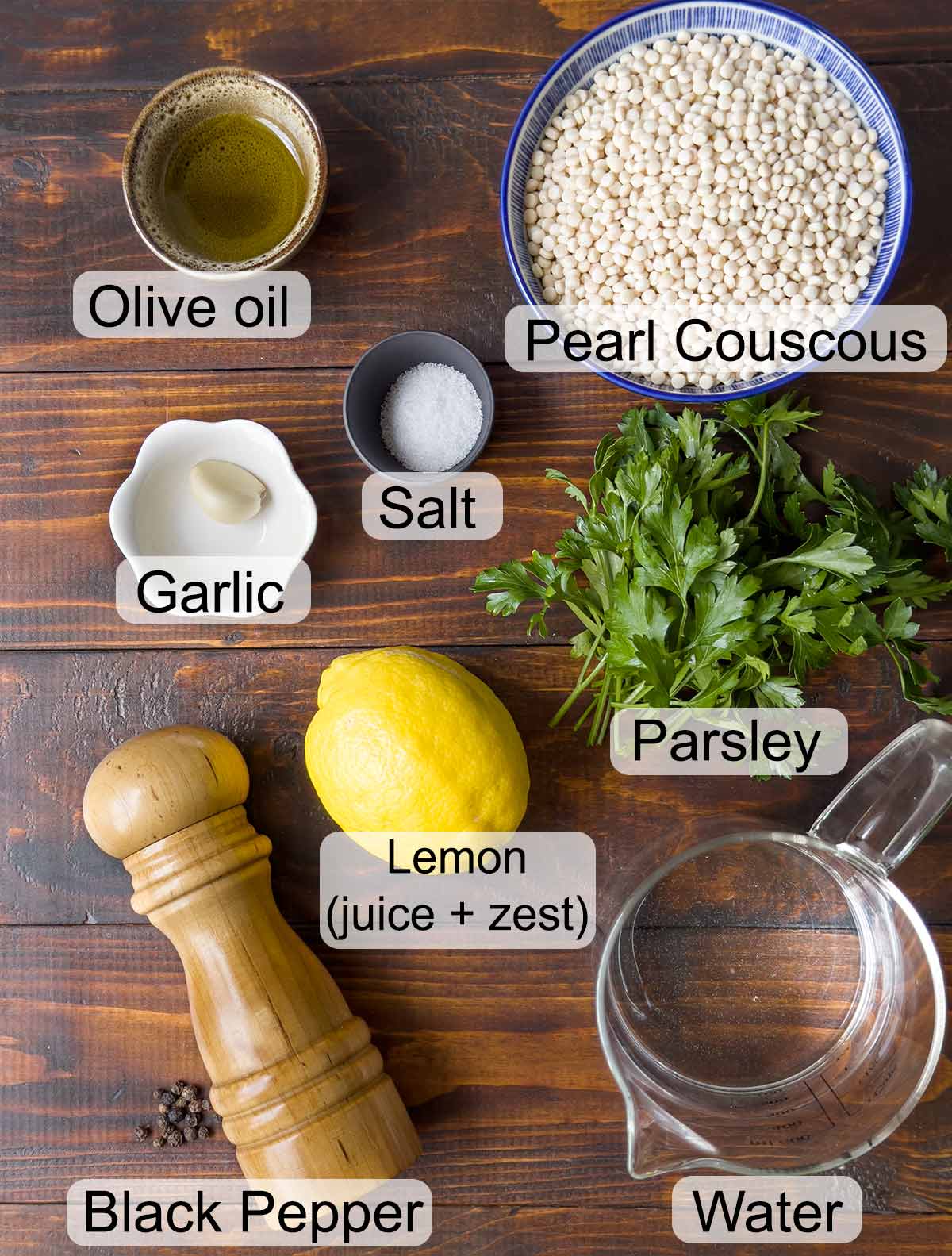
Pearl couscous: For the best results try to find a good quality couscous made from hard wheat flour (you may know it as semola flour). Some brands tend to give mushy couscous especially if it's made from soft wheat flour.
Depending on the area, you may find this type of couscous by the name Maftoul (Palestinian couscous) or Ptitim.
Lemon juice and lemon zest: The lemon zest is used for flavor. The juice makes it fluffier and less sticky.
Tip: Adding some fresh lemon juice to the boiling water will prevent the couscous pearls to stick together. This is because the acidity of the lemon juice reduces the release of starch during cooking.
🥣 Substitutions - Variations
If you like color, a type of giant couscous with spinach and tomato such as Bob's Red Mill Tri color pearl couscous can be used instead of regular pearl couscous.
Use chicken broth instead of water for a richer taste.
Parmesan couscous: Add 2-3 tablespoons of grated parmesan over each plate for a cheesy twist.
Herbed couscous: Except the parsley try adding one or more of your favorite herbs such as chives, green onions, dill, cilantro, basil, mint.
🔪 Instructions (Steps)
Follow this easy step-by-step guide to make the tastiest pearl couscous recipe every time:
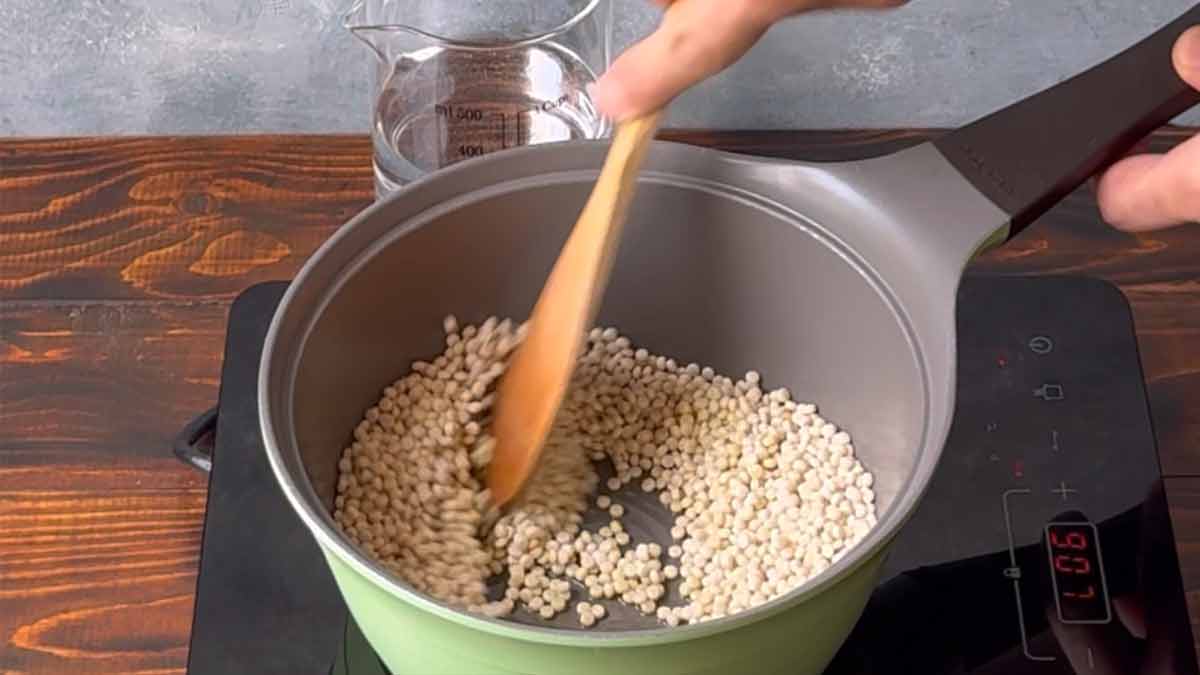
Step 1: Transfer the couscous and the olive oil to a pot and sauté over medium heat, stirring constantly, until the pearls are golden brown and start to smell nutty.
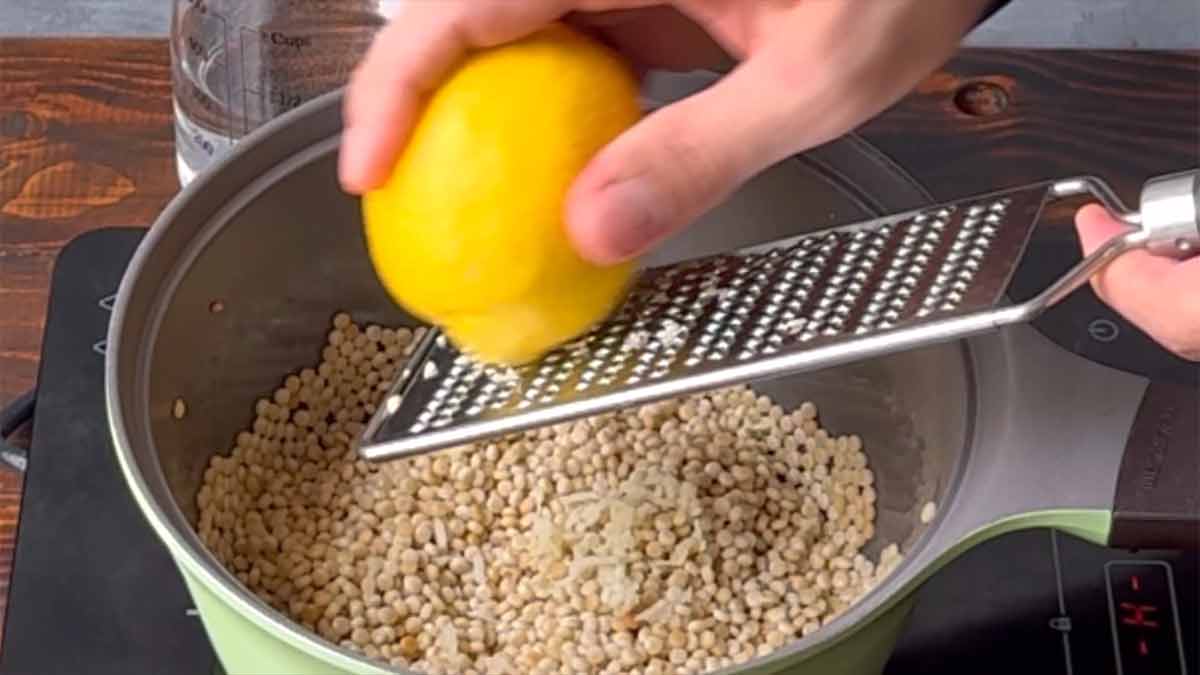
Step 2: Add the minced garlic and the lemon zest and stir for 30-60 seconds.
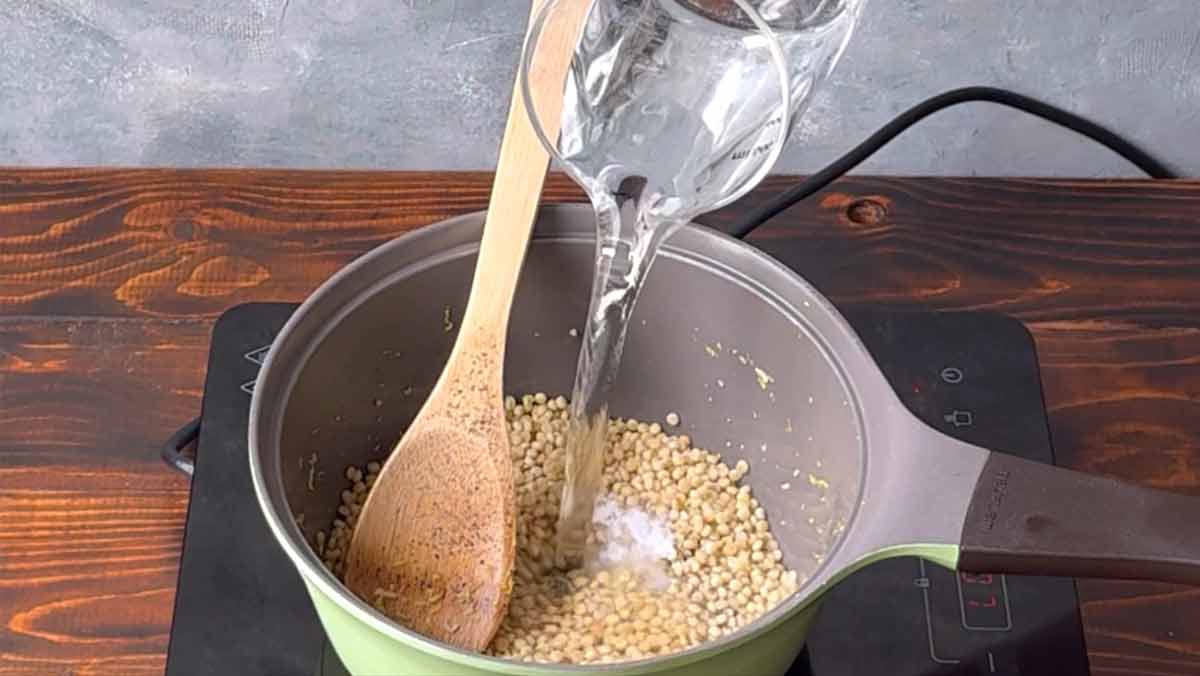
Step 3: Add the salt and the black pepper, the hot water and the lemon juice and bring to a boil.
Instead of water you can also use chicken stock or vegetable broth for a deeper flavor.
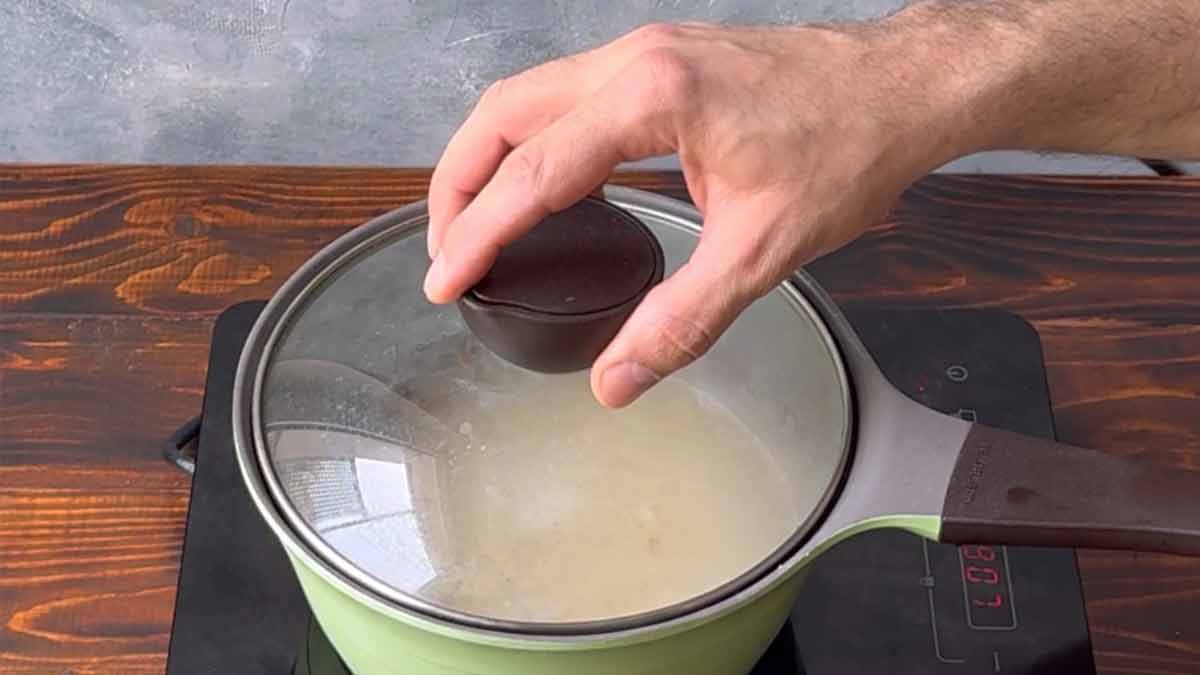
Step 4: Cover the pot with a lid, reduce the heat to a gentle simmer and cook until the water is absorbed and the couscous is tender, about 8-9 minutes.
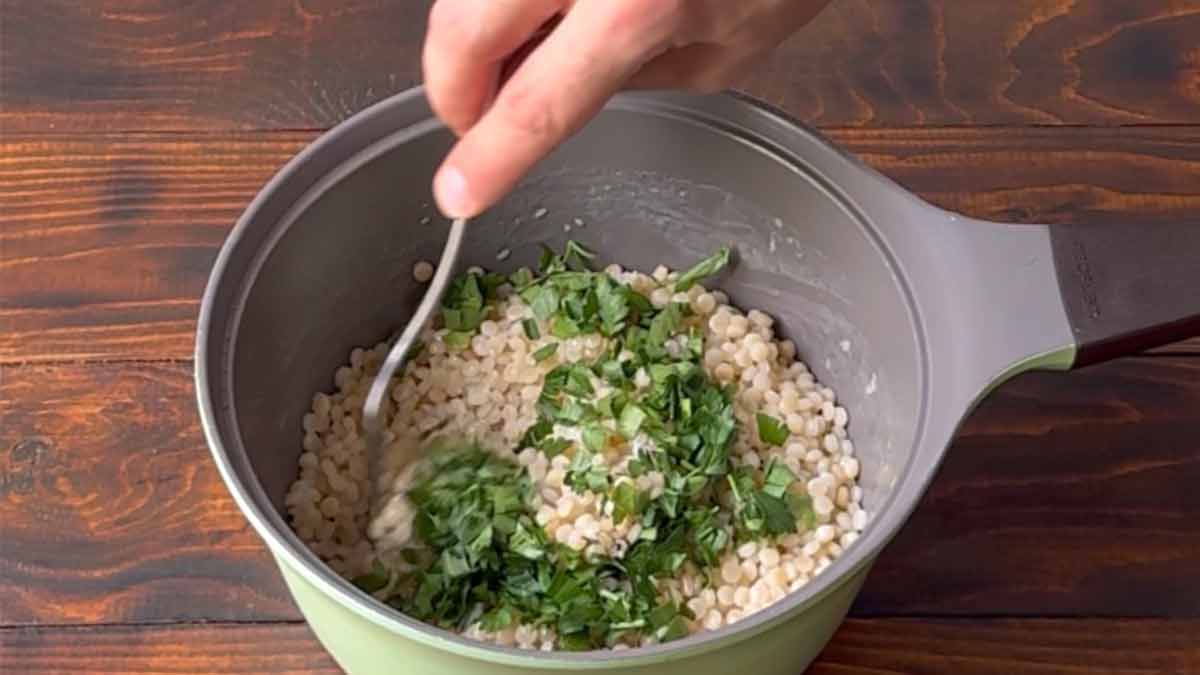
Step 5: Remove the pot from the heat and let it rest (covered with the lid) for 5 minutes. Then, add the chopped parsley and a drizzle of extra virgin olive oil and gently fluff up with a fork.
👨🍳 Expert Tips
✤ You don't need too much lemon zest! Lemon zest is very potent and it can also give a bitter taste to your dish if you use too much.
For a more subtle lemon flavor, instead of the lemon zest use a small piece of lemon rind which you'll discard once the couscous is done.
✤ Sauté the garlic over low heat and not for too long, otherwise it will burn and give a bitter taste to your dish.
✤ If the couscous turns out sticky, rinse with water, drain well and mix with a tablespoon of olive oil.
💭 FAQs
To prepare pearl couscous, you'll need 1 ¼ cups of water for every 1 cup of dry couscous.
This ratio is for couscous cooked in a pot covered with a lid. If you cook it uncovered you may need more liquid.
Toasting the pearls with olive oil before adding the water helps to make couscous not sticky (and also intensifies the taste!).
Adding 1-2 tablespoons of fresh lemon juice to the pot will help to make the pearls less sticky because the acidity of the lemon reduces the release of starch from the pearls.
Cook with plenty of water and drain using a colander.
Mix it with a tablespoon of olive oil. Olive oil coats the surface of the pearls and prevents them from sticking together.
Pearl couscous is a type of pasta made from semolina so it tastes like tiny pasta pearls.
If you take the extra step and sauté it with a bit of oil before boiling it, it will develop a sweet, almost nutty flavor that pairs perfectly with stews, braises, and grilled or roasted vegetables.
50 – 60 grams of couscous per person should be enough if it's meant to be served as a side. 50 grams of pearl couscous is approximately ⅓ cup.
🍳 Food pairing
Pearl couscous can be a delicious, simple side dish served next to meat dishes like roasted lamb leg, pork chops, or this air fryer salmon.
It will also pair perfectly with:
- Falafel recipe (all the secrets)
- Oven baked swordfish recipe with lemon vinaigrette
- Turkey Chili (Mediterranean style recipe)
- Easy honey-balsamic roasted vegetables recipe
And if you struggle with what to cook every day, this monthly meal plan full of Mediterranean recipes is very useful!
Similar Recipes
If you tried this lemon-garlic pearl couscous recipe or any other recipe on my website, please leave a 🌟 star rating and let me know how it went in the 📝 comments below. I love hearing from you!
🎥Recipe Video
📖 Recipe
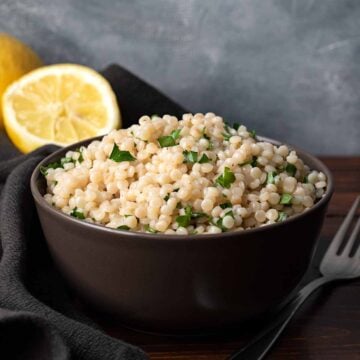
Best Lemon Garlic Pearl Couscous Recipe
Ingredients
- 2 cups (340 g) Pearl Couscous
- 2 tablespoons (24 g) extra virgin olive oil (1 for sauteing and 1 for serving)
- 1 garlic clove (minced)
- 1 teaspoon lemon zest (loose)
- 1 teaspoon salt
- ¼ teaspoon black pepper (ground)
- 2 ½ cups (600 g) hot water or chicken stock (see notes)
- 1 tablespoon (15 g) lemon juice
- 4 tablespoons parsley (fresh, chopped)
Instructions
- Transfer the couscous and the olive oil to a pot and sauté over medium heat, stirring constantly, until the pearls are golden brown and start to smell nutty.
- Add the minced garlic and the lemon zest and stir for 30-60 seconds.
- Add the hot water, the lemon juice, the salt and the black pepper and bring to a boil.
- Cover the pot with a lid, reduce the heat to a gentle simmer and cook until the water is absorbed and the couscous is tender, about 8-9 minutes.
- Remove the pot from the heat and let it rest (covered with the lid) for 5 minutes. Then, add the chopped parsley and a drizzle of extra virgin olive oil and gently fluff up with a fork.*I often add a few tablespoons of Parmesan cheese over each plate for extra taste.
Notes
- Most packaging directions use a higher proportion of liquid but I find it produces couscous with mushy texture. For softer couscous pearls you can increase the liquid to 1 ½ cups water per 1 cup of couscous.
- Some pearl couscous brands (especially those that do not use semolina flour) can turn out mushy or sticky. If that happens, rinse with water and drain well. Then mix with a tablespoon of olive oil and serve.





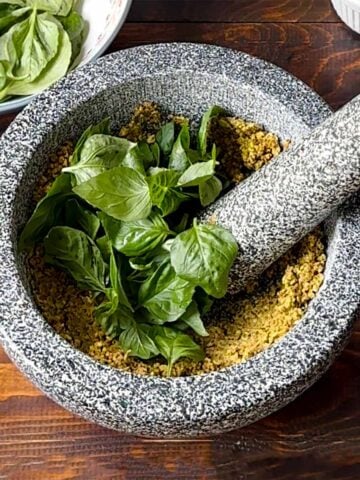



Maria says
Very simple and delicious!
I use it in practically every salad I make
Makos says
Very happy you liked it Maria 🙂
Barbara Hawkins says
Where did you find the pearl Couscous? Your help is much appreciated!!!
Makos says
Hi Barbara, I live in Greece and we have it at big super markets. From what I know you can find it online (Amazon has it) or in the ethnic food aisle
Marguerite Alpers says
In the international aisle at publix
Babass says
It’s not Israeli and it’s not couscous: in North Africa we call it Berkoukess, in Sardinia it’s known as fregola and in Jerusalem it’s called meftoul. There hope to have fixed it for you…quick question: where was this “Israeli” couscous before 1948? The rest of the Mediterranean world should be told.
Makos says
Hi Babass, I'm publishing this comment because I believe that everyone should be able to speak their mind and have their opinion heard.
However, please be more polite in the future. You didn't fix anything and no one asked you to.
Sharee' says
How Rude you are! Love 💕 Israel and Israel couscous!!
Tina says
Love it!
Made it for a salad yesterday and it was delicious.
xxx
Makos says
That's great Tina, I'm very happy to hear that!
Lea says
Hi Makos, used the “no drain” method and only used 1-1/4c chicken broth, after roasting the couscous with a little EVOO. After cooking, I let it rest for a couple minutes, and added Kalamata olives, good feta, red onion, cilantro, salt, black pepper, with a squeeze of lemon. It totally transformed the dish for us! And tomorrow we’ll eat it for lunch with some roasted chicken and a splash or two of good garlicky salad dressing and a more lemon to brighten it. Thank you so much!
Makos says
Hi Lea, that's awesome! Suddenly I got hungry! Wish you a great day:)
George says
I made the drain method because I wanted to make a salad with it but I ended up eating half of it. Even plain it is delicious!
Kathryn says
Absolutely delicious!
Makos says
Thank you Kathryn!
Helen says
I made it with some leftover tomato sauce from your Youvetsi recipe. Very flavorful especially with some crumbled feta on top.
Makos says
Hi Helen, great addition!
Amanda D says
It came out exactly like the photos and it was delicious.
Thanks for this recipe!
Makos says
That's great thanks for the feedback!
Nick says
Hi, I tried this recipe as a beginner cook, and it turned out amazing! The instructions made it seam easy! The couscous was delicious, and I was able to impress my friends with a restaurant-worthy dish(no one believes I made it) . I will experiment with more recipes of you. Thank you.
Makos says
Thank you so much Nick, I'm very glad you liked it!